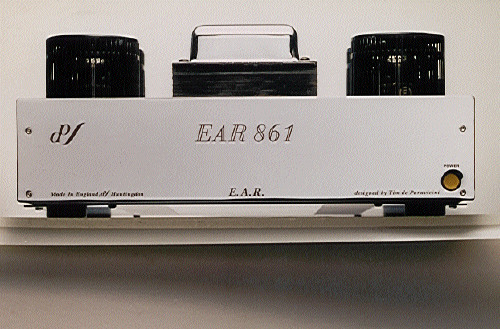E.A.R. 861 Power Amp
E.A.R. 861 Power Amp
$9,695.00
After years of research, development and day-to-day manufacture with the EL519 series of pentode tubes, Tim de Paravicini has come up with a new and exciting Triode configuration. Conventional triode connected pentodes have the second grid tied to the anode, which results in a halfway compromise between a pentode and a triode. This neither has the efficiency of the pentode, nor the linearity of the triode. Tim de Paravicini’s Enhanced Triode Mode (ETM) goes one step further, and creates a true, highly linear triode from a robust pentode tube.
Instead of driving the normal Grid One with signal, this is tied down to the cathode, and thus becomes an invisible, transparent element, and part of the cathode. Signal is fed into the tube’s Grid Two, and in this configuration, Grid Three has no effect – it can either be connected to earth, or left floating. The ETM behaves like a true triode and is in fact more linear than the majority of directly heated triodes. Compared with the latter, it has the additional advantage of being a tough, more robust tube, capable of much longer operational life.
The first amplifier to use the ETM configuration was the ‘859, and with some justification the ‘861 could be regarded as a push-pull version of the ‘859. However, this is more than a slight understatement: each output transformer has a massive 5 kilogram weight, with no feedback applied around it. The circuit is balanced push-pull from input to output, allowing balanced (professional-style) inputs as well as conventional unbalanced (RCA phono jack socket). Similar to the ‘859, the circuit is direct-coupled. Tube choice is not critical; perfect operation does not rely on matched tubes, nor on user adjustable bias.
Output power is 32 watts per channel, 20 Hz – 20,000 Hz. The half power bandwidth is in excess of 16 Hz – 60,000 Hz, both with low total distortion, and no overall feedback. Tube complement: 2 x ECC83, 6 x PCC88 and 4 x EL519. Amplifier weight: 27 kilograms.
Subjectively the amplifier has the same ‘family’ sound as the EAR 859. Listeners will find it builds heavily upon this, with an increase in authority and attack. The lower bass has real grip and feel with this amplifier, way in excess of the 32 watt power rating while the treble is smoother, cleaner and sweeter, mainly due to the lack of overall feedback. A single word can sum up the 861: ‘effortless’. It has real power and control, the power to convey the emotion of the most demanding of recordings, whether the source be our preferred analogue or digital. Check out the review:
1 in stock
Description
After years of research, development and day-to-day manufacture with the EL519 series of pentode tubes, Tim de Paravicini has come up with a new and exciting Triode configuration. Conventional triode connected pentodes have the second grid tied to the anode, which results in a halfway compromise between a pentode and a triode. This neither has the efficiency of the pentode, nor the linearity of the triode. Tim de Paravicini’s Enhanced Triode Mode (ETM) goes one step further, and creates a true, highly linear triode from a robust pentode tube.
Instead of driving the normal Grid One with signal, this is tied down to the cathode, and thus becomes an invisible, transparent element, and part of the cathode. Signal is fed into the tube’s Grid Two, and in this configuration, Grid Three has no effect – it can either be connected to earth, or left floating. The ETM behaves like a true triode and is in fact more linear than the majority of directly heated triodes. Compared with the latter, it has the additional advantage of being a tough, more robust tube, capable of much longer operational life.
The first amplifier to use the ETM configuration was the ‘859, and with some justification the ‘861 could be regarded as a push-pull version of the ‘859. However, this is more than a slight understatement: each output transformer has a massive 5 kilogram weight, with no feedback applied around it. The circuit is balanced push-pull from input to output, allowing balanced (professional-style) inputs as well as conventional unbalanced (RCA phono jack socket). Similar to the ‘859, the circuit is direct-coupled. Tube choice is not critical; perfect operation does not rely on matched tubes, nor on user adjustable bias.
Output power is 32 watts per channel, 20 Hz – 20,000 Hz. The half power bandwidth is in excess of 16 Hz – 60,000 Hz, both with low total distortion, and no overall feedback. Tube complement: 2 x ECC83, 6 x PCC88 and 4 x EL519. Amplifier weight: 27 kilograms.
Subjectively the amplifier has the same ‘family’ sound as the EAR 859. Listeners will find it builds heavily upon this, with an increase in authority and attack. The lower bass has real grip and feel with this amplifier, way in excess of the 32 watt power rating while the treble is smoother, cleaner and sweeter, mainly due to the lack of overall feedback. A single word can sum up the 861: ‘effortless’. It has real power and control, the power to convey the emotion of the most demanding of recordings, whether the source be our preferred analogue or digital. Check out the review:

Reviews
There are no reviews yet.